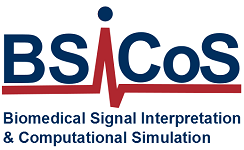-
Projects
Physiology-guided signal processing for cardiac risk stratification and therapy-guided: tools to improve decision-making in cardiac management
Start date
2014
End date
2016
Coordinator
Juan Pablo Martínez
Funding agency
MINECO, TEC2013-42140-R
In this project we aim to investigate and validate novel approaches to extract, model and interpret clinically relevant information derived from cardiovascular signals -invasive and non-invasive- in the context of a number of relevant, highly prevalent diseases, as well as other non-pathological conditions which are suspected to increase cardiovascular risk, such as bed rest or shift working. The main objective is to improve interpretation and physiological characterization of the cardia signals in such conditions, in order to provide the clinicians with precise information and tools to guide and support their decisions on patient management, on the need and choice of apropriate therapy and on its adequate application.
We intend to achieve that goal in two different domains which define the two lines of action in this project: 1) non-invasive cardiovascular risk assessment and quantification and 2) optimized planning of invasive interventions such as atrial or ventricular ablation.
In the first domain, we aim to derive robust signal processing methods to provide noninvasive biomarkers which are reliable predictors of the risk of cardiac death (either sudden or non-sudden). For that purpose we will use mainly the surface ECG signals recorded in routine procedures, such as 10-s ECG, ambulatory recordings and stress tests. In this project we will focus in three pathological conditions: Coronary Artery Disease (myocardial ischemia and infarction), Brugada Syndrome and Congestive Heart Failure, but also in the effect of conditions which are believed to increase cardiovascular risk in the non-diseased heart, as microgravity and shift work. Repolarization, depolarization and autonomic biomarkers will be combined to study to which extent they are explaining the same underlying mechanisms, or whether they are really complementary. We will be able to obtain then a non-invasive signature for the different types of risks in the different studied conditions that can be used for personalized decision making about the therapy, and also for massive screening based on routine tests.
The second domain is that of invasive cardiac signals or electrograms (EGMs). EGMs play a crucial role in guiding the application of the therapy in interventions such as catheter ablation, and also in the operation of implantable devices such as cardioverter-defibrillators or pacemakers. Based on the knowledge of physiology, we aim to derive EGM signal processing techniques to reliably determine activation maps in ventricular tachycardia, to characterize aberrant conduction in myocardial scars and to characterize the atrial substrate in atrial fibrillation. In all three cases, results should help to reduce the time required to decide the appropriate applications of ablation to terminate arrhythmias in these invasive procedures, also reducing the rates of inappropriate applications. Additionally, we will characterize local repolarization changes as observed in unipolar and bipolar EGM during ischemia and infarction, to establish whether it is feasible to use them for risk monitoring in implantable devices.
A keypoint of this project is that the methodological choices that will be taken in its execution will be based on signal models grounded on the established knowledge of the physiology in each studied condition. To ensure this, a multidisciplinar and international team of researchers is involved.
